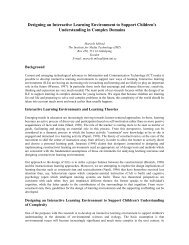Using Quality Assurance Strategies for Online Programs
Using Quality Assurance Strategies for Online Programs
Using Quality Assurance Strategies for Online Programs
You also want an ePaper? Increase the reach of your titles
YUMPU automatically turns print PDFs into web optimized ePapers that Google loves.
maintenance. Prior consideration should be given to factors such as yearendacademic evaluations, the teaching role in the tenure/promotionprocess, and release time <strong>for</strong> online course development, and should bediscussed with appropriate deans and chairs.Faculty should consult with instructional designers, web masters, graphicartists, computer specialists, and in<strong>for</strong>mation resource providers (librarians,copyright experts, etc.) to establish realistic course development expectationsand to develop key support personnel contacts.<strong>Online</strong> focus groups across disciplines will enable faculty to discussstrategies <strong>for</strong> coping with the additional workloads, to monitor and correctnegative influences or attitude changes, to write cross-discipline grants, todetermine academic credit and recognition <strong>for</strong> online course delivery, and todevelop assessment and evaluation procedures.CONCLUSIONCritical mass in virtual campus development occurs with the right combinationof faculty enthusiasm, technological capabilities, administrativesupport, student interest, and the recognition of instructional possibility.We contend, there<strong>for</strong>e, that successful web-based delivery depends onintegrating quality assurance strategies into the program. An organizedapproach through this rubric might provide the framework <strong>for</strong> the design,development, implementation, and management of an effective onlineprogram, and will ensure a successful experience <strong>for</strong> both faculty andstudents.Moving to a web-based program involves a drastic change <strong>for</strong> the traditionalacademy—a change not universally embraced and one that causes dissonancein both faculty and students’ role expectations.Any preconception by students that web-based courses require less work isquickly dispelled when they realize that the workload is equivalent to orgreater than face-to-face classes even though in a much more flexiblecontext. Very quickly, students realize that weekly procrastination—a stancepermissible in face-to-face classes—brings disastrous results in the onlineexperience. If our online students are to be successful, they must become76
















